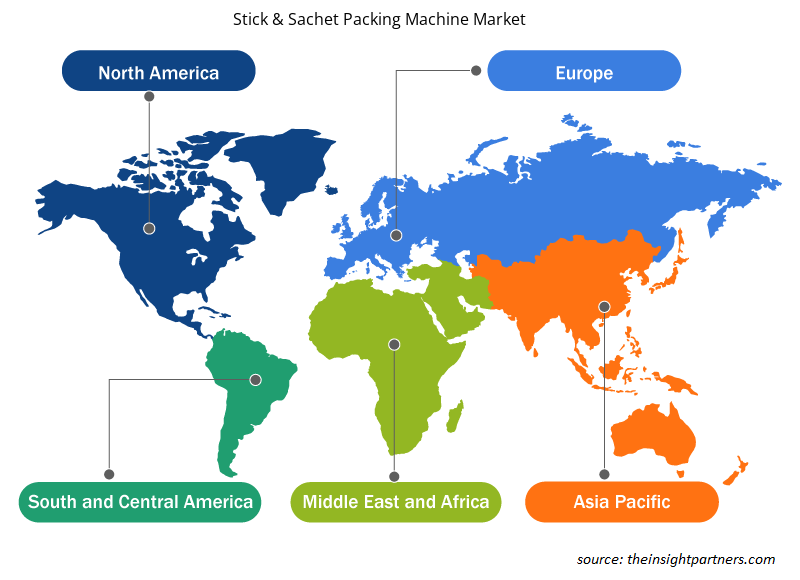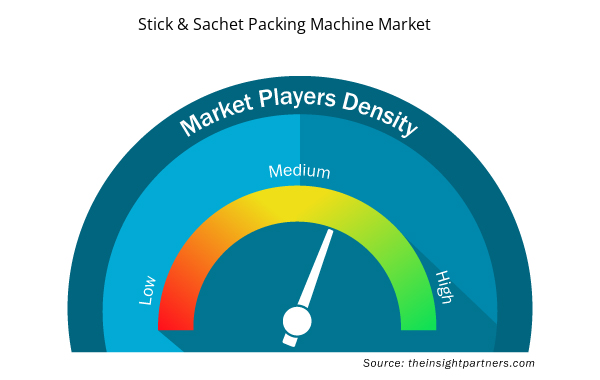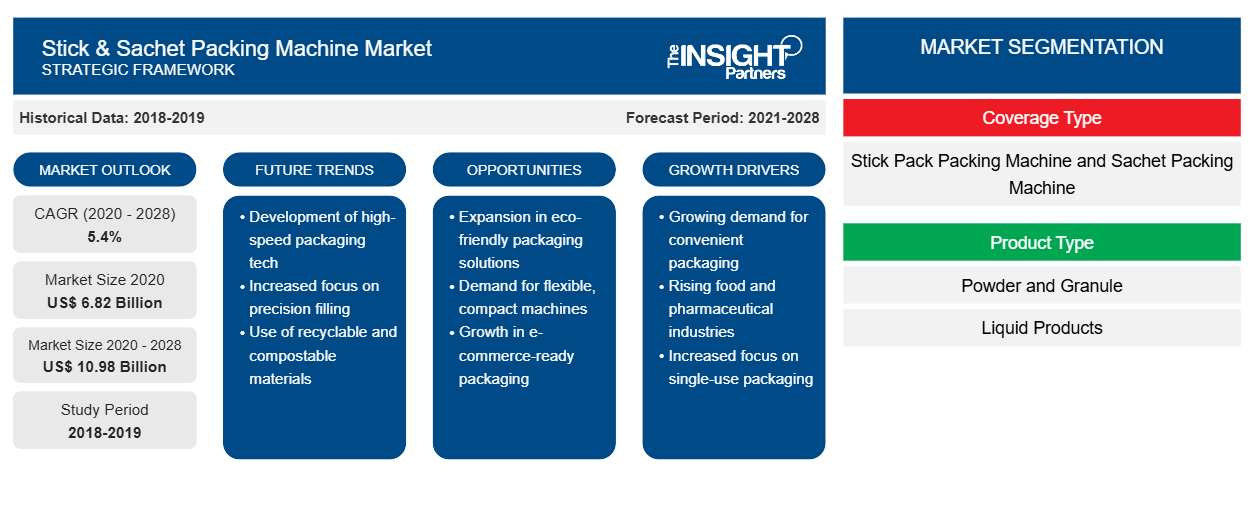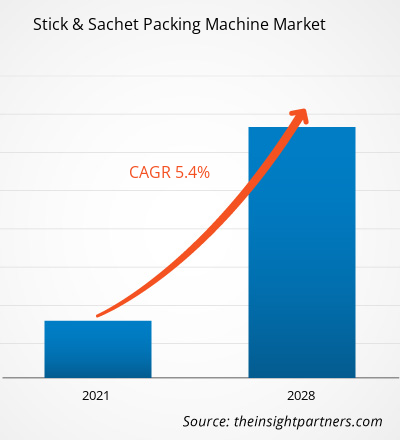Il mercato delle macchine confezionatrici per stick e bustine è stato valutato a 6.819,38 milioni di dollari USA nel 2020 e si prevede che raggiungerà i 10.978,92 milioni di dollari USA entro il 2028. Si stima che registrerà un CAGR del 5,4% durante il periodo di previsione.
La rapida industrializzazione globale, le crescenti preferenze dei consumatori per i prodotti confezionati, la crescita dell'industria alimentare e delle bevande, una crescente attenzione alla fornitura di servizi di manutenzione intelligenti e un'elevata ottimizzazione dei processi di confezionamento sono alcuni fattori che probabilmente stimoleranno la crescita di questo mercato durante il periodo di previsione. Nella proiezione sopra menzionata, l'evoluzione del settore dell'e-commerce e la prevalenza di canali di distribuzione potenziati offrono numerose opportunità per la crescita del mercato globale delle macchine confezionatrici per stick e bustine.
Gli stakeholder chiave nell'ecosistema del mercato globale delle macchine confezionatrici per stick e bustine sono i fornitori di materie prime, i produttori di macchine confezionatrici per stick e bustine e gli utenti finali. I fornitori di materie prime sono gli stakeholder iniziali nel mercato in quanto forniscono vari metalli, come acciaio, acciaio dolce, plastica, plastica rinforzata con fibra di vetro (GRP) e metalli ferrosi. Questi materiali migliorano la qualità dei componenti per prestazioni e durata migliori.
Personalizza questo report in base alle tue esigenze
Riceverai la personalizzazione gratuita di qualsiasi report, comprese parti di questo report, o analisi a livello nazionale, pacchetto dati Excel, oltre a usufruire di grandi offerte e sconti per start-up e università
- Scopri le principali tendenze di mercato in questo rapporto.Questo campione GRATUITO includerà analisi di dati che spaziano dalle tendenze di mercato alle stime e alle previsioni.
Impatto della pandemia di COVID-19 sul mercato delle macchine confezionatrici per stick e bustine
L'epidemia di COVID-19 ha avuto un impatto negativo sulle aziende manifatturiere in tutto il mondo, ma il mercato globale delle macchine confezionatrici per stick e bustine è rimasto relativamente inalterato. La maggior parte delle aziende di imballaggio è pienamente operativa con una maggiore capacità, mentre alcune stanno ancora pianificando di aumentare la produzione. D'altro canto, i principali produttori pianificano di standardizzare le attrezzature utilizzando nuove tecniche per aumentare le vendite sul mercato.
Inoltre, i processi di produzione nella maggior parte dei paesi interessati, come Cina, Italia settentrionale, Germania e Stati Uniti, procedono senza intoppi, sostenendo la crescita del mercato globale delle macchine confezionatrici per stick e bustine.
Approfondimenti sul mercato globale delle macchine confezionatrici per stick e bustine
Tecnica di efficacia complessiva delle apparecchiature (OEE)
La necessità di macchine per l'imballaggio di integrarsi con i processi di produzione a monte ha portato allo sviluppo di tecniche di automazione per diversi settori. La tecnica dell'efficacia complessiva delle apparecchiature (OEE) è utilizzata nelle operazioni di imballaggio snello per controllare il processo di imballaggio. Le operazioni di imballaggio snello sono ora ampiamente utilizzate a causa della crescente necessità di pasti confezionati, farmaci e trattamenti continui e dell'elevata spesa per prodotti di marca, che accelera il mercato globale delle macchine per l'imballaggio di stick e bustine. Inoltre, le aziende di e-commerce in India, Indonesia, Cina e Stati Uniti stanno introducendo pratiche di imballaggio snello, alimentando significativamente la domanda di macchine per l'imballaggio di stick e bustine.OEE) technique is used in lean packaging operations to control the packaging process. Lean packaging operations are now widely used because of the increased need for packaged meals, continuous medications and treatments, and high spending on branded products, which accelerates the global stick & sachet packing machine market. Furthermore, e-commerce enterprises in India, Indonesia, China, and the US are introducing lean packaging practices, fueling the demand for stick and sachet packing machines significantly.
Gli imballaggi flessibili stanno diventando più popolari di altri tipi di imballaggi. Sono costituiti da sviluppi di mercato e fattori di crescita come e-commerce, stampa digitale e sostenibilità. I clienti sono disposti a pagare un prezzo elevato per caratteristiche di prodotto uniche rese possibili dagli imballaggi flessibili. Secondo la Flexible Packaging Association, oltre il 60% dei consumatori nordamericani è disposto a pagare di più per vantaggi tangibili e funzionali degli imballaggi come protezione del prodotto, facilità di trasporto ed efficienza della supply chain. Si prevede che tali fattori amplieranno il mercato delle macchine per l'imballaggio di stick e bustine.
Informazioni sul mercato globale delle macchine confezionatrici per stick e bustine basate sul tipo
In base al tipo, il mercato globale delle macchine confezionatrici stick & sachet è suddiviso in macchine confezionatrici stick pack e macchine confezionatrici sachet. Il segmento delle macchine confezionatrici stick pack è stato valutato a 4.026,08 milioni di $ USA nel 2020 e si prevede che raggiungerà 6.686,56 milioni di $ USA entro il 2028, con un CAGR del 5,7% durante il periodo di previsione.CAGR of 5.7% during the forecast period.
Approfondimenti sul mercato globale delle macchine confezionatrici per stick e bustine in base al tipo di prodotto
In base al tipo di prodotto, il mercato globale delle macchine confezionatrici stick e sachet è segmentato in polvere e granuli, prodotti liquidi e altri. Il segmento potenza e granuli ha guidato il mercato con una quota del 55,6% nel 2020. Si prevede inoltre che rappresenterà il 57,3% del mercato totale entro il 2028.
Macchina confezionatrice per stick e bustine
Approfondimenti regionali sul mercato delle macchine confezionatrici per stick e bustine
Le tendenze regionali e i fattori che influenzano il mercato delle macchine confezionatrici Stick & Sachet durante il periodo di previsione sono stati ampiamente spiegati dagli analisti di Insight Partners. Questa sezione discute anche i segmenti e la geografia del mercato delle macchine confezionatrici Stick & Sachet in Nord America, Europa, Asia Pacifico, Medio Oriente e Africa e Sud e Centro America.

- Ottieni i dati specifici regionali per il mercato delle macchine confezionatrici per stick e bustine
Ambito del rapporto di mercato sulle macchine confezionatrici per stick e bustine
| Attributo del report | Dettagli |
|---|---|
| Dimensioni del mercato nel 2020 | 6,82 miliardi di dollari USA |
| Dimensioni del mercato entro il 2028 | 10,98 miliardi di dollari USA |
| CAGR globale (2020 - 2028) | 5,4% |
| Dati storici | 2018-2019 |
| Periodo di previsione | 2021-2028 |
| Segmenti coperti | Per tipo di copertura
|
| Regioni e Paesi coperti | America del Nord
|
| Leader di mercato e profili aziendali chiave |
|
Densità dei player del mercato delle macchine confezionatrici per stick e bustine: comprendere il suo impatto sulle dinamiche aziendali
Il mercato delle macchine confezionatrici Stick & Sachet sta crescendo rapidamente, spinto dalla crescente domanda degli utenti finali dovuta a fattori quali l'evoluzione delle preferenze dei consumatori, i progressi tecnologici e una maggiore consapevolezza dei vantaggi del prodotto. Con l'aumento della domanda, le aziende stanno ampliando la propria offerta, innovando per soddisfare le esigenze dei consumatori e capitalizzando sulle tendenze emergenti, il che alimenta ulteriormente la crescita del mercato.
La densità degli operatori di mercato si riferisce alla distribuzione di aziende o società che operano in un particolare mercato o settore. Indica quanti concorrenti (operatori di mercato) sono presenti in un dato spazio di mercato in relazione alle sue dimensioni o al valore di mercato totale.
Le principali aziende che operano nel mercato delle macchine confezionatrici per stick e bustine sono:
- Macchinari per imballaggio ARANOW, SL
- Ingeniería de Envasado Vertical SL
- IMA-Ilapak
- Körber AG
- Macchinari per imballaggio Matrix, LLC
Disclaimer : le aziende elencate sopra non sono classificate secondo un ordine particolare.

- Ottieni una panoramica dei principali attori del mercato delle macchine confezionatrici per stick e bustine
Approfondimenti sul mercato globale delle macchine confezionatrici per stick e bustine basate sull'utente finale
Sulla base dell'utente finale, il mercato globale delle macchine confezionatrici stick e sachet è suddiviso in alimenti e bevande, prodotti farmaceutici, prodotti chimici, cosmetici e altri. Il segmento alimenti e bevande è stato valutato a 2.627,18 milioni di dollari USA nel 2020 e si prevede che raggiungerà i 4.118,79 milioni di dollari USA entro il 2028.
I player del mercato globale delle macchine confezionatrici stick & sachet adottano varie strategie, come fusioni, acquisizioni e iniziative di mercato, per rimanere competitivi. Di seguito sono elencati alcuni recenti sviluppi dei principali player del mercato:
- Nel 2021, ARANOW Packaging Machinery, SL ha collaborato con AlliedFlex Technologies per incrementare le vendite in Nord America gestendo la linea di prodotti per macchinari per il confezionamento in stick pack.
- Nel 2022, Syntegon Technology GmbH sta ampliando il suo portafoglio di macchine per il confezionamento del caffè con la macchina per il confezionamento PMX per caffè macinato e chicchi interi. La macchina PMX può essere utilizzata per diversi formati di confezionamento. Inoltre, PMX elabora monomateriali riciclabili e riduce l'utilizzo di energia e materiali tramite il monitoraggio delle condizioni.
Profili aziendali elencati nel mercato globale delle macchine confezionatrici per stick e bustine
- Macchinari per imballaggio ARANOW, SL
- Ingeniería de Envasado Vertical SL
- IMA-Ilapak
- Körber AG
- Macchinari per imballaggio Matrix, LLC
- MESPACK, SL
- OMAG Srl
- SmartPac Verpackungsmaschinen GmbH
- Syntegon Tecnologia GmbH
- Universal Pack Srl
- Analisi storica (2 anni), anno base, previsione (7 anni) con CAGR
- Analisi PEST e SWOT
- Valore/volume delle dimensioni del mercato - Globale, regionale, nazionale
- Industria e panorama competitivo
- Set di dati Excel



Report Coverage
Revenue forecast, Company Analysis, Industry landscape, Growth factors, and Trends

Segment Covered
This text is related
to segments covered.

Regional Scope
North America, Europe, Asia Pacific, Middle East & Africa, South & Central America

Country Scope
This text is related
to country scope.
Domande frequenti
The Global Stick & Sachet Packing Machine Market was dominated by the stick pack packing machine segment in 2020, which accounted for 59.0% of market share. . Compared with other packaging styles, stick packs are easy to manufacture, help achieve high throughput, and conserve valuable plant floor space. The stick pack format is popular for single-serve products that consumers prefer for portability, convenience, and ease of use. In addition, stick packs are narrow, making it easy to pour the products of the package into a bottle of water. Furthermore, a single stick pack conveniently holds a single serving. These compact packs fit neatly in the purse, backpack, or pocket, and maintain the freshness of the filled products. Therefore, aforementioned factors paves the way for more widespread adoption of the segment and will favor the growth of the market.
In 2020, APAC led the market with a substantial revenue share, followed by MEA and Europe. Europe is a prospective market for Global Stick & Sachet Packing Machine Market manufacturers.
The major companies in Global Stick & Sachet Packing Machine Market includes Syntegon, Omag, Aranow, Korber and Mespack.
The global Global Stick & Sachet Packing Machine Market was dominated by the food and beverages based end user segment in 2020, which accounted for 38.5% of market share. The food & beverages industry accounts for ~3% of India’s GDP in 2020 and is the single largest employer, with more than a 7.3 million workforce. The food & beverage industry is one of the most rapidly growing industries leading to the development of food and beverage companies in every continent. In particular, the necessity to be hygienic made it obligatory for the food & beverage industry to move quickly into packaged products. Companies manufacture various types of stick & sachet packing machines to help the user fulfill the rising demand of the consumer. The single-use & disposable machines have two types, sachet (square – four-sided package) and stick (three-sided package), allowing people to gain and consume quickly and easily in today’s fast-moving life. With Twin pack System, the stick pack machines can pack salt and pepper separately into the two joined sachets. These machines provide a high-quality, fast, adjustable weight of sachets. These can also be used for other food sector products, such as white and brown sugar, sweetener, cinnamon, spices, and granular coffee.
Digital printing impacts every aspect of the packaging and shows no indications of slowing down. Packagers have significantly more personalization and customization choices with digital printing than mechanical processes such as typesetting. Within the last decade, most packaging companies converted from traditional to digital packaging. However, entirely retooling a factory takes time. Only a few companies will be left standing in 2022 if they have not jumped on board the digital train and made that progressive investment. Furthermore, digital printing makes customization much easier. This digital trend has been growing for a few years, and it will significantly impact the packaging sector in 2022.
Several logistics and transportation organizations require packaging to wrap and bundle their goods and commodities. As a result, further growth in the logistics and transportation industries is likely to drive demand for stick and sachet packaging machine, boosting the market growth in the near future. Furthermore, the e-commerce business has risen dramatically in recent years, affecting the growth of the stick and sachet packaging machine market. Beyond convenience, other factors such as sustainability, transparency, food safety, and food waste reduction influence the flexible packaging choice for meat, poultry, and seafood in the food business. Companies are more interested in recyclable and recycled-content flexible packaging solutions due to several causes. For instance, formable paper is gaining traction because it has excellent barrier qualities suited for lunchmeat and portion packs and reduces plastic use up to 80%.
Trends and growth analysis reports related to Manufacturing and Construction : READ MORE..
The List of Companies - Stick & Sachet Packing Machine Market
- ARANOW Packaging Machinery, S.L
- Ingeniería de Envasado Vertical S.L.
- IMA-Ilapak
- Körber AG
- Matrix Packaging Machinery, LLC
- MESPACK, S.L
- OMAG S.r.l
- SmartPac Verpackungsmaschinen GmbH
- Syntegon Technology GmbH
- Universal Pack S.r.l
The Insight Partners performs research in 4 major stages: Data Collection & Secondary Research, Primary Research, Data Analysis and Data Triangulation & Final Review.
- Data Collection and Secondary Research:
As a market research and consulting firm operating from a decade, we have published and advised several client across the globe. First step for any study will start with an assessment of currently available data and insights from existing reports. Further, historical and current market information is collected from Investor Presentations, Annual Reports, SEC Filings, etc., and other information related to company’s performance and market positioning are gathered from Paid Databases (Factiva, Hoovers, and Reuters) and various other publications available in public domain.
Several associations trade associates, technical forums, institutes, societies and organization are accessed to gain technical as well as market related insights through their publications such as research papers, blogs and press releases related to the studies are referred to get cues about the market. Further, white papers, journals, magazines, and other news articles published in last 3 years are scrutinized and analyzed to understand the current market trends.
- Primary Research:
The primarily interview analysis comprise of data obtained from industry participants interview and answers to survey questions gathered by in-house primary team.
For primary research, interviews are conducted with industry experts/CEOs/Marketing Managers/VPs/Subject Matter Experts from both demand and supply side to get a 360-degree view of the market. The primary team conducts several interviews based on the complexity of the markets to understand the various market trends and dynamics which makes research more credible and precise.
A typical research interview fulfils the following functions:
- Provides first-hand information on the market size, market trends, growth trends, competitive landscape, and outlook
- Validates and strengthens in-house secondary research findings
- Develops the analysis team’s expertise and market understanding
Primary research involves email interactions and telephone interviews for each market, category, segment, and sub-segment across geographies. The participants who typically take part in such a process include, but are not limited to:
- Industry participants: VPs, business development managers, market intelligence managers and national sales managers
- Outside experts: Valuation experts, research analysts and key opinion leaders specializing in the electronics and semiconductor industry.
Below is the breakup of our primary respondents by company, designation, and region:

Once we receive the confirmation from primary research sources or primary respondents, we finalize the base year market estimation and forecast the data as per the macroeconomic and microeconomic factors assessed during data collection.
- Data Analysis:
Once data is validated through both secondary as well as primary respondents, we finalize the market estimations by hypothesis formulation and factor analysis at regional and country level.
- Macro-Economic Factor Analysis:
We analyse macroeconomic indicators such the gross domestic product (GDP), increase in the demand for goods and services across industries, technological advancement, regional economic growth, governmental policies, the influence of COVID-19, PEST analysis, and other aspects. This analysis aids in setting benchmarks for various nations/regions and approximating market splits. Additionally, the general trend of the aforementioned components aid in determining the market's development possibilities.
- Country Level Data:
Various factors that are especially aligned to the country are taken into account to determine the market size for a certain area and country, including the presence of vendors, such as headquarters and offices, the country's GDP, demand patterns, and industry growth. To comprehend the market dynamics for the nation, a number of growth variables, inhibitors, application areas, and current market trends are researched. The aforementioned elements aid in determining the country's overall market's growth potential.
- Company Profile:
The “Table of Contents” is formulated by listing and analyzing more than 25 - 30 companies operating in the market ecosystem across geographies. However, we profile only 10 companies as a standard practice in our syndicate reports. These 10 companies comprise leading, emerging, and regional players. Nonetheless, our analysis is not restricted to the 10 listed companies, we also analyze other companies present in the market to develop a holistic view and understand the prevailing trends. The “Company Profiles” section in the report covers key facts, business description, products & services, financial information, SWOT analysis, and key developments. The financial information presented is extracted from the annual reports and official documents of the publicly listed companies. Upon collecting the information for the sections of respective companies, we verify them via various primary sources and then compile the data in respective company profiles. The company level information helps us in deriving the base number as well as in forecasting the market size.
- Developing Base Number:
Aggregation of sales statistics (2020-2022) and macro-economic factor, and other secondary and primary research insights are utilized to arrive at base number and related market shares for 2022. The data gaps are identified in this step and relevant market data is analyzed, collected from paid primary interviews or databases. On finalizing the base year market size, forecasts are developed on the basis of macro-economic, industry and market growth factors and company level analysis.
- Data Triangulation and Final Review:
The market findings and base year market size calculations are validated from supply as well as demand side. Demand side validations are based on macro-economic factor analysis and benchmarks for respective regions and countries. In case of supply side validations, revenues of major companies are estimated (in case not available) based on industry benchmark, approximate number of employees, product portfolio, and primary interviews revenues are gathered. Further revenue from target product/service segment is assessed to avoid overshooting of market statistics. In case of heavy deviations between supply and demand side values, all thes steps are repeated to achieve synchronization.
We follow an iterative model, wherein we share our research findings with Subject Matter Experts (SME’s) and Key Opinion Leaders (KOLs) until consensus view of the market is not formulated – this model negates any drastic deviation in the opinions of experts. Only validated and universally acceptable research findings are quoted in our reports.
We have important check points that we use to validate our research findings – which we call – data triangulation, where we validate the information, we generate from secondary sources with primary interviews and then we re-validate with our internal data bases and Subject matter experts. This comprehensive model enables us to deliver high quality, reliable data in shortest possible time.


 Ottieni un campione gratuito per questo repot
Ottieni un campione gratuito per questo repot